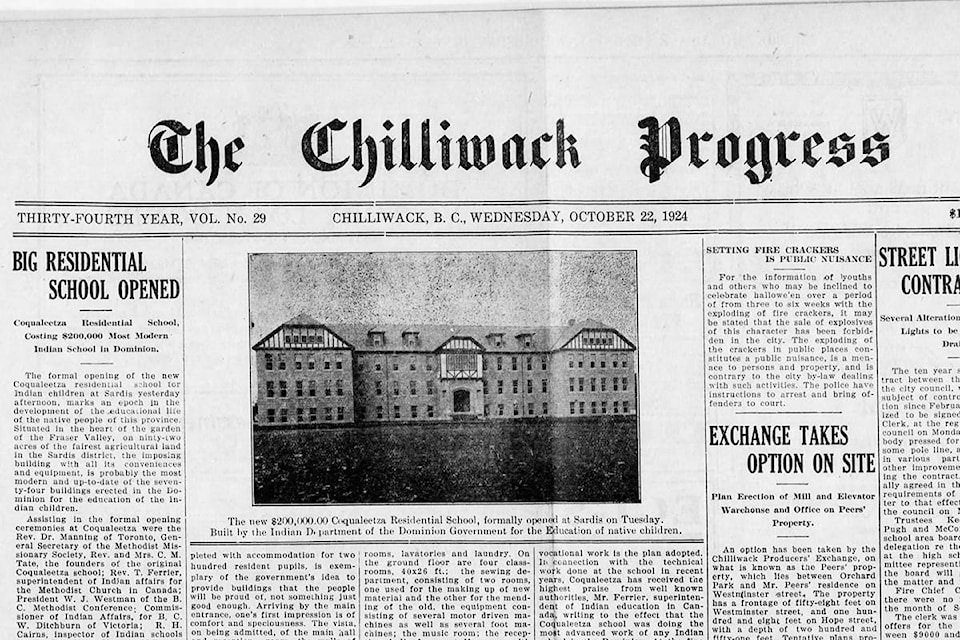Unless you have been living under a rock, it’s hard to fathom how anyone can ponder the anniversary of Canadian confederation on July 1 this year without at least a little more reflection than normal.
In the weeks leading up to Canada Day, reports dominated news coverage of the remains of 215 people, mostly children found in unmarked graves at the site of the former Kamloops Indian Residential School in Tk’emlúps te Secwépemc territory.
Then 751 unmarked graves at a “school” site in Saskatchewan. (I put “school” in quotes as these were not places of education. To quote Indigenous studies professor Wenona Hall in our June 25 edition, residential schools were at best “child labour camps, and at worst they were death camps.”)
As part of the City of Chilliwack’s Canada Day online event held July 1 in partnership with local Rotary clubs, I participated by writing and reading three short vignettes based on some cursory research in The Chilliwack Progress’s extensive online archives that date back to 1891.
See below for the two other vignettes.
The top story on the May 2, 1894 newspaper was about the formal opening of the Industrial Institute for the training of Indian Children at the Coqualeetza site. That was also the year that an amendment to the Indian Act made attendance at residential schools mandatory for children between 7 and 16.
RELATED: Canada Day as seen through an Indigenous lens
RELATED: University of the Fraser Valley professor ponders a Canada Day like no other
Those who attended were mostly not local Sto:lo children. Children were intentionally sent far away from their communities to the schools to discourage contact, something that might counteract the efforts to destroy the Indian in the child, the stated goal of the residential schools.
A compelling part in the story, however, is a quoted address read “on behalf of the Indians” in response to the Indian Superintendent in town that day.
“The white people were not here first,” read the words transcribed and attributed to Captain John, Dick, Billy, Jed, Ned and Joe. “By tradition we can trace our ancestry back for many generations and it has been handed down to us that this land always belonged to the Indians.” And: “We are troubled when we are told that we must no longer catch our fish in the way we have always caught them.”
Some things really haven’t changed.
The top story in the Oct. 22, 1924 Progress was under the headline: “Big residential school opened,” with a photo of the $200,000 Coqualeetza Residential school.
This was big news, deemed “an epoch in the development of the educational life of the native people of this province.”
The Methodist church ran Coqualeetza, one of many churches that ran the schools across Canada under the rule of law from Ottawa.
Sixteen years later in the Dec. 14, 1938 Progress, and article with the headline: “A World Within a World, Best Describes Coqualeetza Indian Residential School.”
The writer must have been given a tour of the big brick building said to remain “much of a mystery to the average resident of Chilliwack and district.”
In none of these stories, unsurprisingly, were Indigenous leaders, parents of the children, let alone the children themselves, asked their opinion on the policy and the nationwide disgrace that has been called cultural genocide by so many, including the Truth and Reconciliation Commission in 2015.
Today as we report on Chilliwack and the Sto:lo and the settler history of the region, things are ever more complex.
There are also glimmers of reconciliation as Indigenous people take control over some portions of the land, their land. We see commercial and residential development on reserve lands in our community, while as settlers we also learn more and more about the culture that Canada sought to destroy.
We at The Progress are not perfect, and we have no Indigenous reporters on staff, but we are allies. In that, all we can do is open our minds to the stories and leave a space for them to be told.
Any major development these days requires consultation with local First Nations.
If we are to get anywhere with reconciliation in Canada, I think it’s clear we need to do less talking and more listening.
There is some cognitive dissonance this Canada Day as we celebrate our nations successes but we are reminded of our colonial past, and the fact that we cannot pretend the legacy of cultural genocide didn’t happen with residential schools.
Some have pointed to a sort of national relativism: Canada has done OK, many other countries have even worse histories of abuse to their Indigenous people. Many other nations have been slower than Canada to redress past harms, to move towards reconciliation.
And while this may be true, the fastest tortoise who wins the race shouldn’t be smug.
Do you have something to add to this story, or something else we should report on? Email:
editor@theprogress.com
Like us on Facebook and follow us on Twitter.
